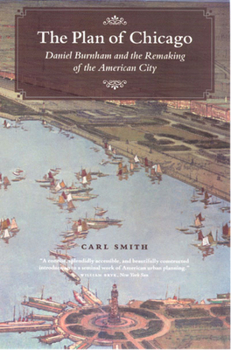The Plan of Chicago: Daniel Burnham and the Remaking of the American City
(Part of the Chicago Visions and Revisions Series)
Select Format
Select Condition 
Book Overview
Arguably the most influential document in the history of urban planning, Daniel Burnham's 1909 Plan of Chicago, coauthored by Edward Bennett and produced in collaboration with the Commercial Club of Chicago, proposed many of the city's most distinctive features, including its lakefront parks and roadways, the Magnificent Mile, and Navy Pier. Carl Smith's fascinating history reveals the Plan's central role in shaping the ways people...
Format:Paperback
Language:English
ISBN:0226764729
ISBN13:9780226764726
Release Date:August 2007
Publisher:University of Chicago Press
Length:202 Pages
Weight:0.60 lbs.
Dimensions:0.5" x 5.5" x 8.5"
Customer Reviews
5 ratings
Excellent Description of How the Plan of Chicago Originated
Published by Thriftbooks.com User , 15 years ago
This book expertly describes how Daniel Burnham was the main force behind developing Chicago's plan for urban development in 1909. It was advanced with support including Progressives and business leaders who desired planning order. Prior to this, Chicago had quick yet haphazardly with no overall plan. Developers were noted for creating some buildings were notable architectural features. Yet concerns over poor sanitation and other problems associated with rapid urban growth made people demand foresight in future growth. Daniel Burnham had led the City Beautiful campaign that sought well connected and landscaped roads. There was public support for making the city more visually attractive, and they liked shade trees, beautiful buildings, and open squares that offered statutes and fountains. Some, such as Jane Addams, wanted more done to correct the social disorders that existed. The Chicago Plan had its critics. Louis Sullivan, an architect, felt the plan gave too much favoritism to business interests. He also disagreed with the modern architecture it advanced. Burnham had supported creating a six mile park along Chicago's waterfront. This became part of the Plan of Chicago. The Plan looked ahead at what it thought Chicago should become. It looked little at what Chicago was like. The plan worried about speculation and unregulated growth. It was believed the quality of life of city residents was at stake. The Plan called for more parks, wider streets, and more diagonal streets. It did not focus more on living and employment standards. Roads and transit lines were planning. Houses and businesses were left to locate according to market forces. Daniel Burnham was hired by associations of business leaders to direct the creation of the Plan of Chicago. They saw the plan as a means to protect their interests. The Commercial Club was supportive of a proposal to expand Michigan Avenue and create two layers in that section of the city. The Plan called for better schools, parks, and playgrounds to improve the lives of people in poverty and in slums. Parts of the Plan were implemented. Michigan Avenue was developed, parkland increased along the lake side, and formal landscaping occurred in Grant Park, Wacker Drive was partially developed to plan, several streets were widened, and Union Station was constructed. Parts were not implemented, such as constructing a civic center at a recommended location. A Chicago Plan Commission plan in 1939 became the subsequent working Chicago planning document. The Plan had its critics in retrospect. Lewis Mumford, a historian, believed the Plan was too favorable towards business interests that wanted real estate prices to increase. Jane Jacobs, an urban affairs critic, argued the Plan hurt neighborhoods when it should have been improving them.
Thought-provoking!
Published by Thriftbooks.com User , 15 years ago
This concise, well-researched, well-written book tells the story of the first and most famous City Plan in North America. It covers its historical, urban and organizational contexts, its contents as well as its promotion, implementation and heritage. While subtle and never overtly critical, the author is no blind admirer of the Burnham Plan and provides a mature and balanced description of events prior and after its publication. The reader is given reference to a scanned copy of the actual 1909 Plan on [...]. He is free to ponder on how much _ and in a sense, how little _ planning documents have evolved in the past 100 years. This book is highly recommended to anyone interested in urban planning, especially of course to those familiar with Chicago.
Why Does Chicago Look the Why it Does?
Published by Thriftbooks.com User , 16 years ago
A must read for anyone interested in Daniel Burnham or Chicago history and planning. Chicago is a very well-planned city. If you've ever wondered why it seems and is much more organized than other large, metro cities, you will certainly know after reading this book.
Good Background
Published by Thriftbooks.com User , 17 years ago
I liked the book. As someone who recently moved to Chicago, I have a lot to learn about the city's past. This book gives a good overview of Chicago and the part that the Burnham and Bennett Plan played in the formation of the city, up to its present form. I would definitely recommend this book to anyone interested in Chicago, social history, or in urban planning.
Gripping, tightly written book
Published by Thriftbooks.com User , 18 years ago
As an architecture tour guide, I've read "The Plan of Chicago" and know some Chicago history. Smith succinctly summarizes prevailing circumstances so the reader knows the context of the development of The Plan, but he deftly includes colorful and precise detail. The book is under 200 pages, reflecting a distinctive self-restraint by this distinguished scholar at Northwestern University. Moving from background of Chicago history and of Daniel Burnham, Smith summarizes the Plan's development, describes the other players, analyzes the Plan's effects, and brings readers quickly up-to-date with urban planning of today. This excellent narrative, supplemented with photographs not commonly seen, ends with a "bibliographic essay" to guide interested readers in their subsequent investigations.





